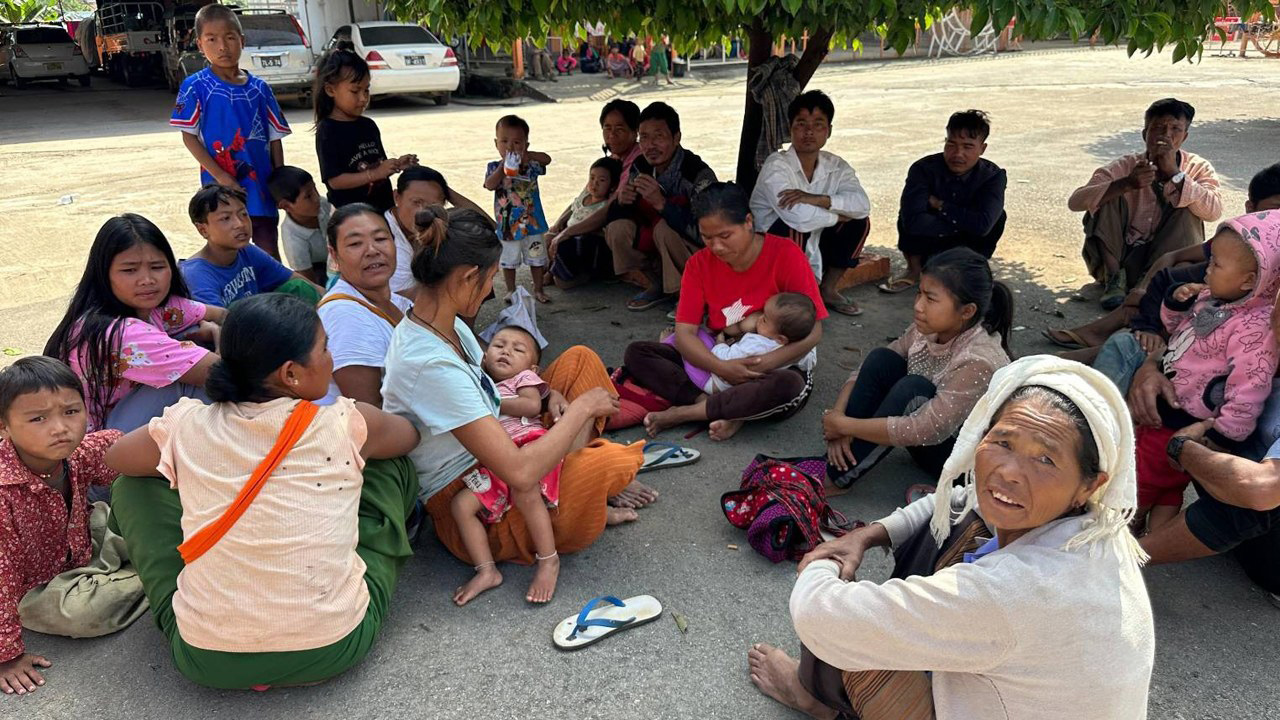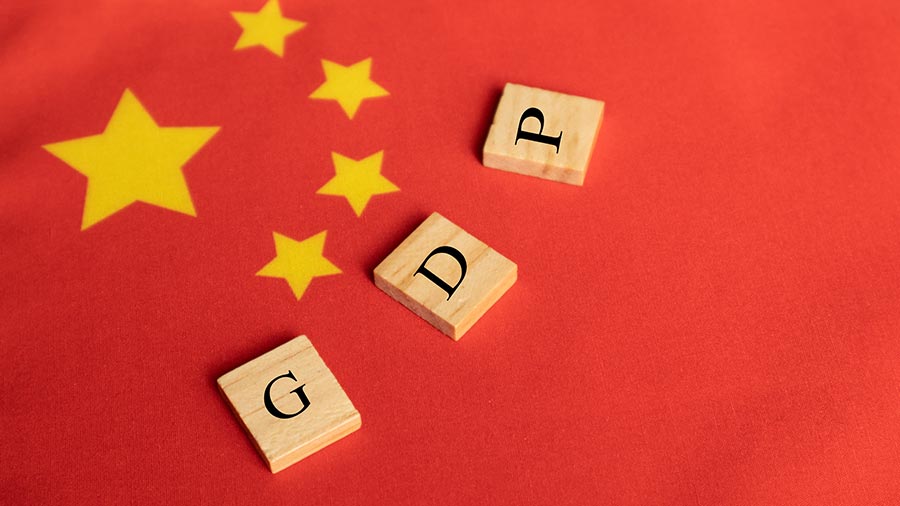China
5,000 Myanmar nationals flee into China, face shortages

Some 5,000 Myanmar nationals, including hundreds of children, who fled into China amid an ethnic army offensive in northern Shan state are in dire need of food and water in Yunnan province, the displaced and their family members said Friday.
On Oct. 27, the Northern or “Three Brotherhood” Alliance of the Myanmar National Democratic Alliance Army, the Arakan Army and the Ta’ang National Liberation Army launched “Operation 1027” – named for the date of the offensive.
The groups simultaneously struck junta positions in the strategic Shan cities of Kunlong, Hseni, Chin Shwe Haw, Laukkaing, Namhkan, Kutkai, and Lashio, the state’s largest municipality.
Fierce fighting in the vicinity of Chin Shwe Haw at the start of the offensive forced some 5,000 residents to cross the border and take up temporary shelter in Yunnan province, Thet Naing, a family member of one of the displaced, told RFA Burmese.
On Thursday, Chinese authorities transferred the displaced to Yunnan’s Mengding township, where they are now sheltering at a former COVID-19 testing center, he said.
“They said they moved to the vicinity of Mengding and are living in a room there – I heard that it’s a building formerly used as a COVID-19 center,” Thet Naing said. “They said that the entire camp was moved by vehicles last night because there might be another fierce fight in Chinshwehaw.”
Water shortage
But supplies are short at the center, located around 30 kilometers (20 miles) east of Chin Shwe Haw, and those sheltering there – including around 700 children – need food, water, and supplies, said one of the displaced, named Ko Sai.
“Because of the water shortage, we have to boil water we received for bathing, and some of us are suffering from diarrhea,” he said. “Many are experiencing health problems and some have fainted.”
Ko Sai said the center is being “guarded by the Chinese police and army,” and that the reason for the water shortage “is because they aren’t allowing donations.”
In addition to residents of Chinshwehaw, other displaced people at the center include migrant workers from northern Shan, Kachin and Rakhine states, he said, as well as Yangon, Mandalay and Sagaing regions.
Chinese authorities have provided the displaced with tents, which can accommodate anywhere from five to 10 people each, he added.
Scant and poor food
Htoo Htoo, another displaced Myanmar national at the center, told RFA that while Chinese authorities are providing two meals a day, “the food isn’t good.”
“They provided us with eggs and tomatoes the past two days … but I can’t eat the eggs and tomatoes served today,” he said. “The tomatoes are spoiled, so I can only eat rice … [and while they have offered pork], many people felt nauseated after eating it.”
Htoo Htoo said that the displaced “are not allowed to cook” and that police had even “confiscated” bread and drinking water he ordered with his own money from outside the center.
Additionally, goods like sanitary napkins “are difficult to get” because of the restrictions on donations, he added.
Sources at the center said that when they asked authorities to get them food and water on Thursday, they were “forced to disperse.”
In addition to the shortages, the displaced said they have mostly been unable to contact their families because authorities “confiscated our phones,” but noted that Myanmar phone and internet services – normally accessible across the border – had been cut since the fighting began.
People at the center told RFA that they want to be allowed to move back across the border to a refugee camp in Shan state’s Nam Thit town, which is under the control of the ethnic United Wa State Army. Barring such a move, they want authorities at the camp to provide them with enough food and water, they said.
Attempts by RFA to contact the Chinese Embassy in Yangon for comment on the issue of Myanmar nationals fleeing into China went unanswered, as did calls to junta Deputy Information Minister Major Gen. Zaw Min Tun and the Myanmar Embassy in Beijing.
Yan Naing, the information officer of the Myanmar National Democratic Alliance Army, or MNDAA, said that the displaced “may have difficulty” returning to their homes, given the severity of the fighting.
“Our organization helps to take care of those displaced by fighting to the best of our ability,” he said. “Right now, during the operation, it is quite difficult to … return to their homes.”
Fighting rages on
The fighting in northern Shan state has displaced some 25,000 people since the start of the offensive – around 10,000 in Nam Tit, another 10,000 in cities in northern Shan – including Hseni, Lashio, Kunlong and Mone Koe – and 5,000 in China’s Mengding.
With roads and transportation cut off as clashes raged, residents of Shan told RFA that there is “no aid for the displaced.”
In a statement on Thursday, the U.N. Office for the Coordination of Humanitarian Affairs said there have been clashes in at least nine out of 22 townships in northern Shan state, and that the number of displaced persons had reached “more than 23,000.”
The Northern Alliance said that during the eight days of Operation 1027, it had captured more than 90 junta outposts, as well as six armored vehicles. The alliance said it “effectively controls the cities of Chinshwehaw, Hpawng Hsen and Kyu Koke.”
Myanmar junta chief Senior Gen. Min Aung Hlaing said at a meeting of his Cabinet held in Naypyitaw on Thursday that his regime would “strike back” against those who attack it.
Translated by Htin Aung Kyaw. Edited by Joshua Lipes and Malcolm Foster.
Read the rest of this article here >>> 5,000 Myanmar nationals flee into China, face shortages
Business
China Reports Agreement on Ceasefire between Myanmar’s Factions

Myanmar’s conflicting parties have reached a ceasefire agreement, facilitated by China, aiming to reduce violence and promote peace in the region.
Myanmar Ceasefire Agreement
In a significant development, conflicting parties in Myanmar have reached an agreement for a ceasefire, with China facilitating discussions. This breakthrough is crucial for restoring peace in a nation that has been marred by violence and political strife in recent years. The ceasefire aims to pave the way for reconciliation efforts and improve the humanitarian situation in affected areas.
Role of China
China’s involvement as a mediator highlights its growing influence in resolving regional conflicts. The Chinese government has been working closely with both sides to promote dialogue and trust, crucial elements for a long-term peace solution. Increased stability in Myanmar can benefit regional security and economic development, making China’s mediation significant.
Looking Forward
The hope is that this ceasefire will lead to further negotiations addressing underlying issues in Myanmar. While challenges remain, both parties have expressed willingness to work towards a peaceful resolution. The international community will be watching closely to see if this ceasefire can be sustained and lead to enduring peace for the people of Myanmar.
China
2024 China Economic Review: GDP, Trade, and Foreign Direct Investment Analysis

In 2024, China’s economy grew 5%, supported by stimulus measures, strong exports, and high-tech investments, despite weak domestic demand and demographic challenges. Key sectors like manufacturing and digital economy thrived, necessitating structural reforms for sustained growth into 2025.
China’s economy grew 5% in 2024, driven by stimulus measures, strong exports, and high-tech investment, despite challenges like weak domestic demand and demographic pressures. Structural reforms and targeted policies are essential for sustaining growth into 2025.
China’s economic performance in 2024 saw a return to steady growth, achieving a 5 percent GDP expansion in line with the government’s target, as per the official data released by the National Bureau of Statistics (NBS) on January 17, 2025. This outcome was largely bolstered by stimulus measures that helped drive a stronger-than-expected fourth-quarter recovery. While the country’s economy faced challenges such as declining population numbers and sluggish consumer demand, there were signs of optimism across key sectors, including industrial output and digital economy growth.
Additionally, China is beginning to pivot away from its dependence on the property sector, with the digital economy playing an increasingly significant role in economic expansion.
This article explores the major economic highlights from 2024 and examines the key trends, challenges, and opportunities that will shape China’s economy in the year ahead.
In 2024, China’s GDP reached RMB 134.91 trillion (US$18.80 trillion), maintaining its position as the second-largest economy in the world, behind only the United States, whose projected GDP for 2024 stands at approximately US$29 trillion. This reflects a year-on-year growth of 5.0 percent, in line with the government’s official target of “around 5 percent“ set during the 2024 Two Sessions. While slower than the 5.2 percent growth achieved in 2023, it highlights a stable recovery largely driven by strong export performance and targeted stimulus measures throughout the year.
The economy saw accelerated growth in the final quarter of 2024, with GDP expanding by 5.4 percent, surpassing expectations and making a substantial contribution to the overall 5.0 percent increase. Indeed, quarterly growth performance in 2024 showed steady improvement: the first quarter recorded a 5.3 percent increase, followed by 4.7 percent in Q2, and 4.6 percent in Q3.
Sectoral performance highlights revealed the manufacturing and service sectors as key drivers.
| This article was first published by China Briefing , which is produced by Dezan Shira & Associates. The firm assists foreign investors throughout Asia from offices across the world, including in in China, Hong Kong, Vietnam, Singapore, and India . Readers may write to info@dezshira.com for more support. |
Read the rest of the original article.
China
How China’s appetite for salmon could reshape global seafood markets – new research

China’s salmon demand surged 46% in 2023, prompting global exporters to respond. Challenges in domestic salmon production highlight opportunities for rainbow trout, reshaping the seafood market towards sustainability and consumer preferences.
China’s demand for farmed salmon is growing at an unprecedented pace. In 2023, its imports grew by 46% year on year – with imports of fresh and chilled Atlantic salmon up 63%.
This remarkable growth is reshaping the global seafood trade. Exporters from Scotland, Norway, Chile, Australia, Faroe Islands, Canada and Iceland are racing to supply the needs of this vast and rapidly evolving market.
At the same time, China’s efforts to produce its own Atlantic salmon have faced significant challenges, highlighting the need for substitutes like rainbow trout to meet the country’s growing appetite for seafood delicacies.
An important shift occurred in 2018, when the Chinese government permitted rainbow trout to be labelled and sold as salmon. This decision blurred the distinction between imported Atlantic salmon and locally farmed rainbow trout, creating a more accessible option for cost-sensitive consumers.
Trout is comparable to salmon in appearance and size, with firm and oily meat that has a similar orange-pink colour. Nutritionally too, the species are alike, as are the ways in which they can be cooked and prepared.
In our new research which included taste tests, we found that many Chinese consumers could not distinguish between domestic rainbow trout and imported Atlantic salmon in blind testing. But when informed about the origin, testers’ preferences shifted strongly in favour of imported Atlantic salmon, highlighting the power of provenance in consumer tastes.
Although people’s willingness to pay did not vary initially in our blind tests, it became a decisive factor once the origin of the fish was revealed.
But we found that origin alone was not enough. For our testers to be prepared to pay higher prices, they also had to like the look, smell and taste of the product more, or be persuaded by its ecolabel (indicating environmental standards).
Environmental costs
Transporting Atlantic salmon from Scottish lochs, Norwegian fjords or Chilean waters to Chinese markets involves complex logistics and significant environmental costs. The carbon footprint of this trade, combined with the resource-intensive nature of salmon aquaculture, raises critical concerns about sustainability.
These challenges are particularly pronounced in China, where consumers have a strong preference for freshness. This drives demand for quick delivery of imported salmon despite its environmental impact, and consumers are increasingly turning to online platforms to buy their seafood.
E-commerce has reshaped seafood retail in China, offering quick delivery and products that cater to consumer demand for quality and freshness. Salmon stands out in this market due to its perceived high value, premium quality and price point. Unlike other expensive seafood that often needs to be sold live to maintain its value, salmon retains its appeal when chilled or frozen.
This makes salmon particularly suited to modern retail models, where sophisticated cold-chain logistics ensure its freshness without the complexities of live transport. However, these innovations come at a cost.
The energy-intensive storage and rapid transportation required for imported salmon contribute significantly to environmental harm. As China’s seafood market continues to grow, addressing the sustainability challenges associated with this trade will be critical to balancing consumer demand with environmental responsibility. Current international certification schemes aiming to improve the sector’s sustainability have had limited impact in China so far.
A worker processing imported fresh salmon in a Beijing wholesale seafood market.
David Little, Author provided
China has made significant efforts to establish a domestic Atlantic salmon industry, but these attempts have largely been unsuccessful due to technical challenges and environmental constraints. This has left a gap that domestically farmed rainbow trout is poised to fill.
A trout farming raceway in Chengdu, China, supplied with fresh river water.
Zixuan Ma, Author provided
In 2022, China produced 37,000 tonnes of rainbow trout. This is a relatively small amount compared with international production levels, but still notable considering that rainbow trout is a new farmed species in China, unlike traditional species like carp.
However, rainbow trout farming in China is geographically constrained, as the species thrives in cooler freshwater temperatures found in higher-lying lakes and reservoirs, as well as in “raceways” (channels supplied continuously with fresh water diverted from rivers).
Advances in aquaculture systems offer a potential pathway to expand China’s production. Trout farming is a more sustainable, locally sourced alternative to Atlantic salmon that reduces the carbon footprint associated with imports and ensures fresher options for Chinese consumers. Developing a robust domestic trout industry could enhance food security, reduce dependence on imports, and create economic opportunities in rural areas.
China’s evolving seafood market offers valuable lessons for the global industry. Emphasising quality, freshness and sustainability will resonate with the increasingly sophisticated Chinese consumer.
At the same time, investment in eco-friendly aquaculture practices, both domestically and internationally, will be essential to balance the growing demand for premium seafood with environmental responsibility. These could include reducing feed waste and recirculating aquaculture systems (which filter and reuse water) to minimise water use. Recycling waste nutrients by using them elsewhere in food production could also be key.
As rainbow trout gains prominence in China’s seafood landscape, the relationship between consumer preferences, environmental concerns and economic opportunities could in turn shape the future of the global salmon trade.
If domestic fish captures a larger share of the Chinese market, salmon producers in Europe, Canada and other exporting regions may face significant challenges. This could ultimately force them to rethink their strategies in order to adapt to shifting market dynamics.
Although the goal of creating a domestic Atlantic salmon industry has proved difficult for China, trout farming presents a practical and sustainable solution for its luxury seafood sector.
This article is republished from The Conversation under a Creative Commons license. Read the original article.








